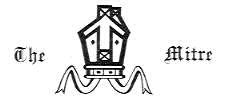| VOL.1 No.1 |  |
JUNE 1961 |
The Magazine of St. Michael's School, Ingoldisthorpe
EDITOR G. S. BARKER, VI SUB-EDITOR M. H. CATERICK, Va
FIRST
-
ISSUE
The founding of a school magazine is a hazardous undertaking, and it is with considerable misgiving that we place this first copy of 'The Mitre' before our readers. Together, the school and I have attempted to give a picture of Saint Michael's as it looks to us, and we hope that the result will not be too alarming for any parents or members of staff who may care to look at it!
A great deal of space is, of necessity, taken up by reports on the various school activities, and we possess the advantage - I think it can be termed unique - of being able to print a Driving Review prepared by the Head Boy, C. Ratcliff.
Being a church school, interest is inevitably centred around church music and the various services, and our Sacristan has had the task of preparing an account of church activities from the beginning of the school year to the time of going to press.
Looking back - over the past months, we can hardly claim to have had a boring time. The Headmaster's sudden illness last November rendered the school leaderless, but, under the able guidance of the staff, headed by Mr. H. Tayler, and the Senior Prefects, we soon recovered the initiative and the Christmas Term was a successful one which saw an important innovation in the appointing of twelve Senior Prefects with special ties; in the Headmaster's absence, Mr. Tayler conducted the inauguration, which was much appreciated by the senior part of the school.
The return of Mr. Pott in December was the signal for us to resume normal transmission and both the Carol Service and the Concert held to mark the end of the year were successful.
Generally speaking we have had an interesting and eventful year, with the addition to the staff of Mr. B Davies, who came to us direct from the University of Durham and the setting-up of a new boys' boarding house at Wolferton under the direction of the Rev. R.H. Tomlinson the Rural Dean.
We look forward to success in the coming cricket and athletics season, and to a fine summer for our studies.
G. S. BARKER, VI (Editor)